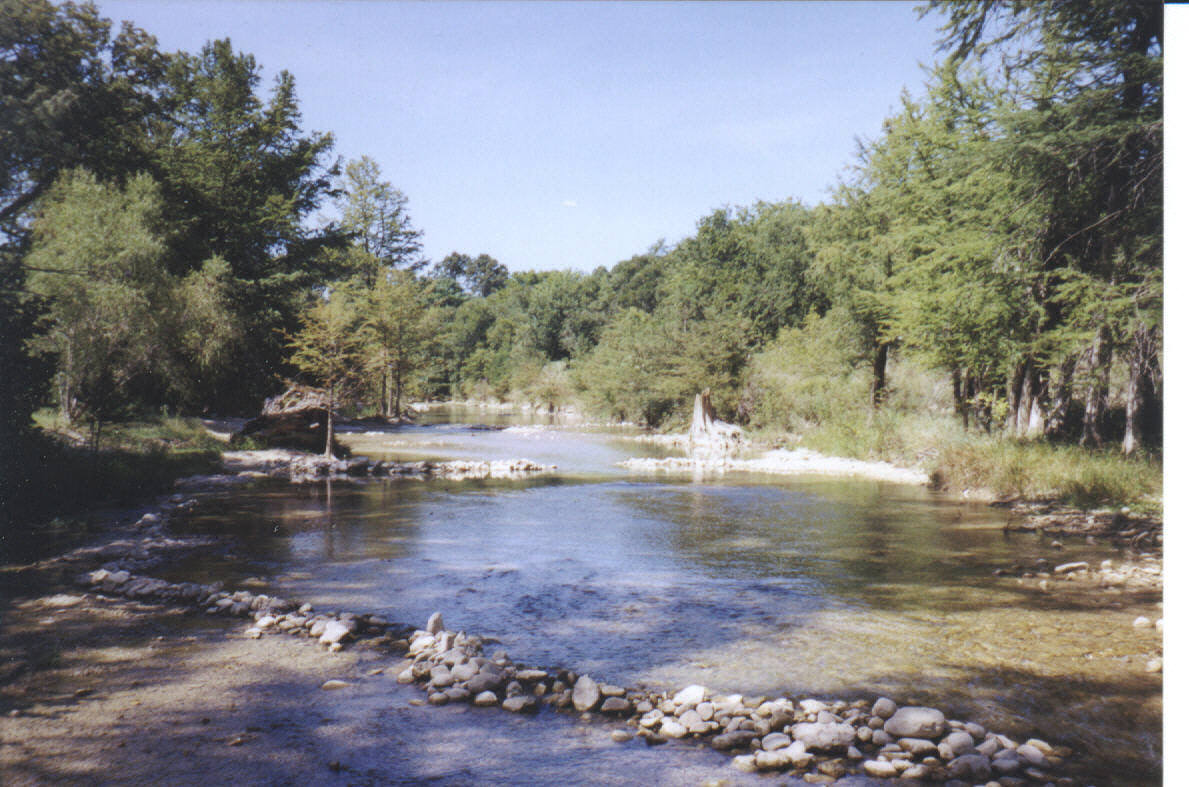
| Tasia Baur | U.S. History 1302-Fall 2005 |
| Monica Cochran |

| Tasia Baur | U.S. History 1302-Fall 2005 |
| Monica Cochran |
Medina, Texas
The Apple Capital of Texas
Medina is a quiet, little town located in the beautiful Texas Hill Country. On the map, it can be found at the intersections of Highway 16 and Farm Road 337. It’s just 12 miles northwest of Bandera in the center of Bandera County. Medina has beautiful scenery, full of rolling hills and the lovely Medina River. The area is known for its abundance of wildlife. When I first visited the town, I thought, “Now, this is what Texas is supposed to look like!”
Jack Phillips, a Deputy Sheriff for Bandera County, was the last man to be killed by Indians in Bandera County.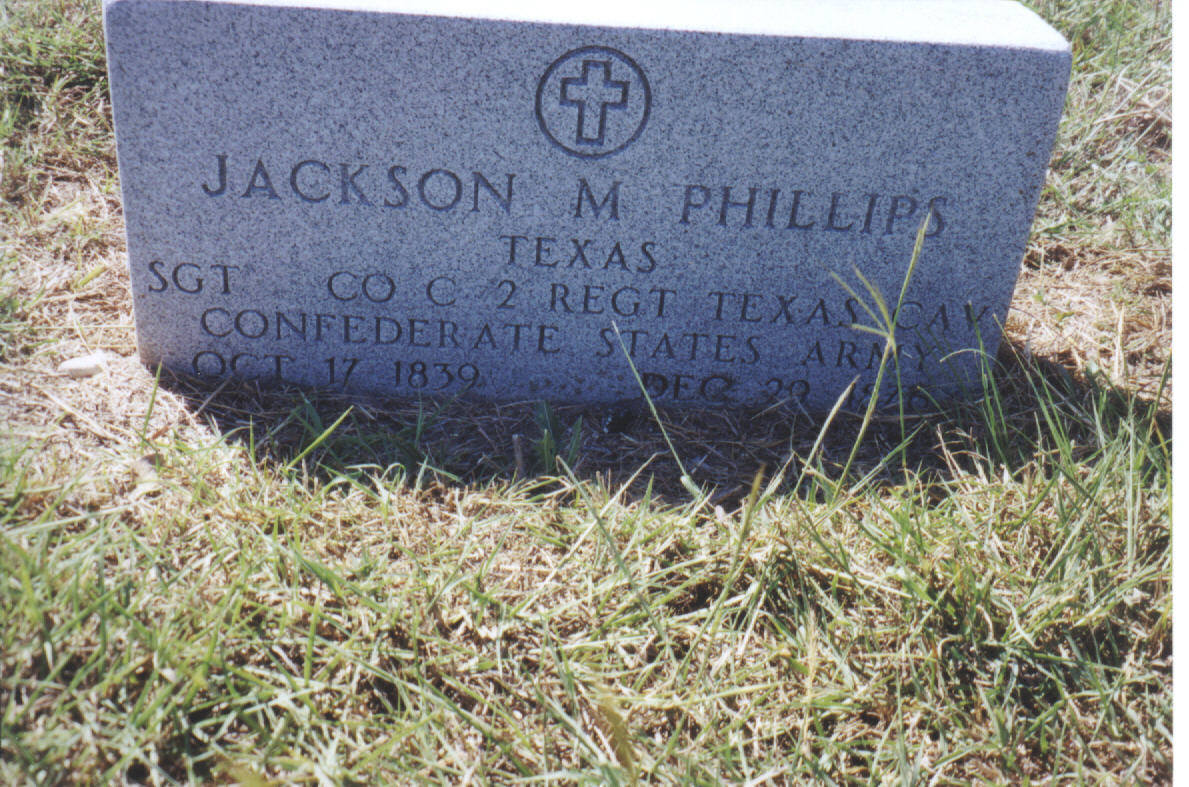 Buck Hamilton, the Sheriff and Jack's brother-in-law,
had sent Phillips on some official business near Seco Pass. Phillips had to stay over night. The next morning, Phillips had just passed through a gate near Seco Canyon when he saw Indians. He tried to get back through the gate, but was too slow. The Indians chased him for a half a mile and shot his horse through the shoulder. The horse fell, but Phillips didn’t give up. He ran on foot until the Indians caught and killed him. Mr. William Felts and Miss Josephine Durban found his body as they were on their way to Bandera to get married. Phillips was lying face down, he was stripped and mutilated. His death in 1876 caused a delay in Medina’s settlement
Buck Hamilton, the Sheriff and Jack's brother-in-law,
had sent Phillips on some official business near Seco Pass. Phillips had to stay over night. The next morning, Phillips had just passed through a gate near Seco Canyon when he saw Indians. He tried to get back through the gate, but was too slow. The Indians chased him for a half a mile and shot his horse through the shoulder. The horse fell, but Phillips didn’t give up. He ran on foot until the Indians caught and killed him. Mr. William Felts and Miss Josephine Durban found his body as they were on their way to Bandera to get married. Phillips was lying face down, he was stripped and mutilated. His death in 1876 caused a delay in Medina’s settlement
ORIGINS
The person who actually named Medina is unknown. However, it’s believed to be named for the river that runs through the town. The river got its name from the Spanish explorer, Alonzo de Leon. According to his diary, he named it on April 11, 1869, during his first journey to America. An old Spanish map shows Medina as a Lipan Apache campground. The Medina area was an Indian stronghold for many years. It was such a popular hunting and camping site of the Indians that several different tribes fought over it. The Indians’ love of this area kept whites from permanent settlement for a long time. In July of 1838, 1,280 acres of land northeast of the Medina river was granted to Antonio Curvier by the Texas government. This land was sold at public auction on July 1, 1841 upon Curvier’s death. John James bought the 1,280 acres of land along with an additional 1,069 acres. In 1864,General John Bell Hood purchased 1,069 acres from James. W.R. Fleming bought the property from General Hood in 1871. Fleming sold the property to H.H. Carmichael in 1876. In October of 1878, Charles Parker bought the property from Carmichael. Parker sold the property the following year to B.F. Bellows in 1879. Bellows divided the property at the future town site into lots and began selling it off. People started moving into the town site and surrounding areas as news spread that the Indian raids had ended. Floyd L. Benton was named postmaster on March 2, 1880. This date was adopted as the official start of the town. At first, the town was called Medina City. The “city” was dropped from the name when the town didn’t develop as planned. (Pioneer History of Bandera County)
FOUNDING FAMILIES
Medina was an Indian stronghold which kept it from being settled by whites for many years. Fresh water, plentiful game, and the level valley made it an ideal campsite. These attributes made the area desirable to both Indians and whites. Whites tried to settle the area in the 1850’s and 60’s, but most were killed or ran off by Indians. Most of the people who settled in Medina came from the South or other parts of Texas. These people were used to a more civilized environment where it was easy to live. They faced many hardships to live in Medina, among these were Indian attacks, floods, and fires. The ones who stayed were very courageous people. These are a few of those brave settlers.

Jack and Lucy (Wells) Stevens were early settlers of Medina. Jack was born in Green County, Tennessee on February 6, 1838. He moved to Atascosa County, Texas with his uncles in 1854. Jack and Lucy were married in March of 1866 shortly after Jack returned from serving in the Civil War. They moved to the Medina area in November and purchased a small property on Hick’s Creek where they lived for two years. In 1868, they moved farther up the creek about four miles below Medina. At that time, their only neighbors on the creek were the Hicks, Taylor, and Pue families. (One Hundred Years of Bandera)
The Bauerlein family were also early settlers of the Medina community.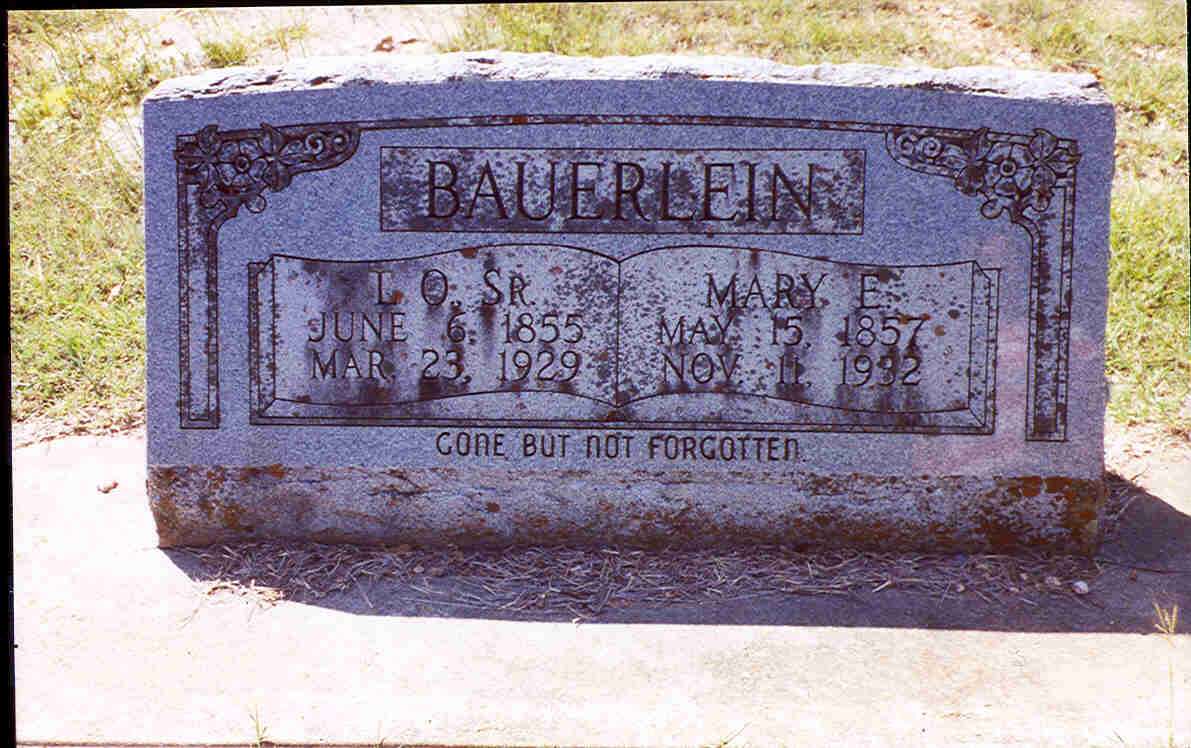 Henry Bauerlein moved just below Medina in 1868. In 1875, his son Charles and his wife, started a home on the West Prong of the Medina river shortly after their marriage. They are believed to be the first permanent settlers in that area. The Crockett, Bennett, and Elam families were some of the first settlers at the head of the river.
Henry Bauerlein moved just below Medina in 1868. In 1875, his son Charles and his wife, started a home on the West Prong of the Medina river shortly after their marriage. They are believed to be the first permanent settlers in that area. The Crockett, Bennett, and Elam families were some of the first settlers at the head of the river.
The Keese brothers moved to the Medina area in 1870. Thomas H. Keese and his family moved to Laxson Creek. Thomas and his family had a run of bad luck when they first arrived. The 1870 flood washed away everything they owned after only one week of residence. After this, they moved to the North Prong of the Medina river where Indians stole their horses and team of oxen. Next, they moved about five miles out on the West Prong where they remained for a number of years. James E. Keese and his family moved just north of present day Medina. Some of James’ neighbors were the Hinds, Benton, Hough, and Chamberlain families.
William and Eliza Sheppard moved to the West Prong of Medina river in 1865. Their son Thomas is known as “the Father of Medina”. It is believed that Thomas and his brothers may have been running a store since 1878 outside the town’s limits. In 1881, he established the first store in Medina. James Walker built the building that the store was housed in and Thomas Sheppard organized and ran the business for many years. Thomas also served as Medina’s second postmaster from 1881 to 1887. Some of the Sheppard’s early neighbors were the Lewis and Chisum families.
These are just a few of Medina’s early settlers. There were several other families. One of the things that I liked about Medina is a lot of these early families are still in the area. These people liked the area so much that they dealt with overwhelming adversity to stay and their descendants are still there today. I think that shows that those early sacrifices were worth it.
ECONOMY
The economy in Medina is much different today than it was a 125 years ago. The first people who came to Medina were cypress shingle makers.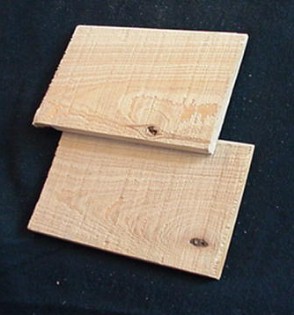 This would be considered Bandera County’s first industry. In 1854, Richard Davis established the first shingle making camp. His camp was five miles below the town site along the Medina River. The cypress logs were sawed into 32 inch lengths, twice the length of an ordinary shingle. These blocks were then hauled up from the river bottoms, cut into two, and marked off at the proper thickness. They were then hauled into San Antonio to be sold. There were no cypress trees on the West Prong of the Medina River, so people did other things to make money. People burned cedar to make coal. Ox wagons hauled the coal to San Antonio to sell. They got approximately .40 cents to a dollar for a 40-pound bag. Other people found different means of making a living by raising livestock. Majority of the economy in the early postwar period was dependent on cattle ranching. In 1870, the county had 4,740 cattle and was a popular place for cattle drives up the Western Trail. However, though the economy was booming in 1870, cattle drives were declining. Sheep and goats became easier to raise because they were better suited to the climate and land. Wool making became an important industry.
This would be considered Bandera County’s first industry. In 1854, Richard Davis established the first shingle making camp. His camp was five miles below the town site along the Medina River. The cypress logs were sawed into 32 inch lengths, twice the length of an ordinary shingle. These blocks were then hauled up from the river bottoms, cut into two, and marked off at the proper thickness. They were then hauled into San Antonio to be sold. There were no cypress trees on the West Prong of the Medina River, so people did other things to make money. People burned cedar to make coal. Ox wagons hauled the coal to San Antonio to sell. They got approximately .40 cents to a dollar for a 40-pound bag. Other people found different means of making a living by raising livestock. Majority of the economy in the early postwar period was dependent on cattle ranching. In 1870, the county had 4,740 cattle and was a popular place for cattle drives up the Western Trail. However, though the economy was booming in 1870, cattle drives were declining. Sheep and goats became easier to raise because they were better suited to the climate and land. Wool making became an important industry.  By 1880, sheep outnumbered cattle 32,974 to 9,471 in Bandera county. The county produced 296,578 pounds of wool. In 1880, Angora goats were also becoming very popular for their mohair. (Texas Handbook Online) Mohair began being shipped to France in significant quantities during the late 1880's. Besides raising animals, farmers grew corn, oats, hay, and various types of grains. Around 1880, people tried to make a living selling cotton, but unfortunately boll weevils ruined this crop. At one time Medina was a thriving town, it had all sorts of different things; such as a skating rink, movie theater, meat market, hardware store, four grocery stories, two grist mills, three drug stores, and much more. The economy has changed. There are only a few businesses left. The majority of the people who live in Medina are retired because most of the young people have moved away. People have to either have money or commute to larger communities for work to live in Medina. Medina’s economy is now based upon apples, sheep, tourism, hunting, and various businesses. Love Creek Orchards is the biggest agricultural venture in Medina at this time. Baxter Adams introduced apples to Medina in 1981 when Love Creek Orchards planted it’s first dwarf apple trees. A few years later, Baxter Adams started the Apple Festival. The Apple Festival began as a gathering of friends and then grew larger from there.
By 1880, sheep outnumbered cattle 32,974 to 9,471 in Bandera county. The county produced 296,578 pounds of wool. In 1880, Angora goats were also becoming very popular for their mohair. (Texas Handbook Online) Mohair began being shipped to France in significant quantities during the late 1880's. Besides raising animals, farmers grew corn, oats, hay, and various types of grains. Around 1880, people tried to make a living selling cotton, but unfortunately boll weevils ruined this crop. At one time Medina was a thriving town, it had all sorts of different things; such as a skating rink, movie theater, meat market, hardware store, four grocery stories, two grist mills, three drug stores, and much more. The economy has changed. There are only a few businesses left. The majority of the people who live in Medina are retired because most of the young people have moved away. People have to either have money or commute to larger communities for work to live in Medina. Medina’s economy is now based upon apples, sheep, tourism, hunting, and various businesses. Love Creek Orchards is the biggest agricultural venture in Medina at this time. Baxter Adams introduced apples to Medina in 1981 when Love Creek Orchards planted it’s first dwarf apple trees. A few years later, Baxter Adams started the Apple Festival. The Apple Festival began as a gathering of friends and then grew larger from there.
HISTORICALLY SIGNIFICANT STORIES
Most of the historically significant stories around Medina are about Indian raids. The Indians were the biggest obstacle that the early settlers faced. Many people were killed or ran off by the Indians. These stories should give you a better understanding of what these settlers were dealing with. Here are a couple of stories about the settler’s experiences.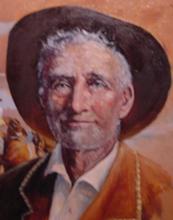
Big Foot Wallace was one of the most famous settlers of the Medina area. He was known for being a great hunter, soldier, Indian Scout, and Texas Ranger. On August 21, 1849, he was granted 320 acres of land about five miles above Medina. This was not a desirable area because it was deep in Indian territory. However, Mr. Wallace had some experience with Indians, so he invited the chiefs of the Lipans to his home. He served them a feast of “bear meat and honey” and “sweetened coffee” He explained to the chiefs that he was just one man and they were a powerful tribe. He asked them to enter into a treaty with him. In the treaty he asked that they leave him and his stock alone and in exchange he would act peacefully towards them. They agreed and the treaty was kept for many years. Over time, Big Foot Wallace had acquired quite a herd of horses. One night the Indians couldn’t resist the temptation and they stole all of his horses. In outrage, Mr. Wallace went to San Antonio and asked for volunteers from the Texas Rangers to help him get his horses back. Many of the Rangers were his friends and 30 volunteered to help. They tracked the Indians and engaged in a fight. Forty-eight Indians were killed. The Texas Rangers lost two men and five were wounded. One hundred and seventy horses were recovered, many of them belonged to Big Foot Wallace. They also found several other items belonging to the settlers.
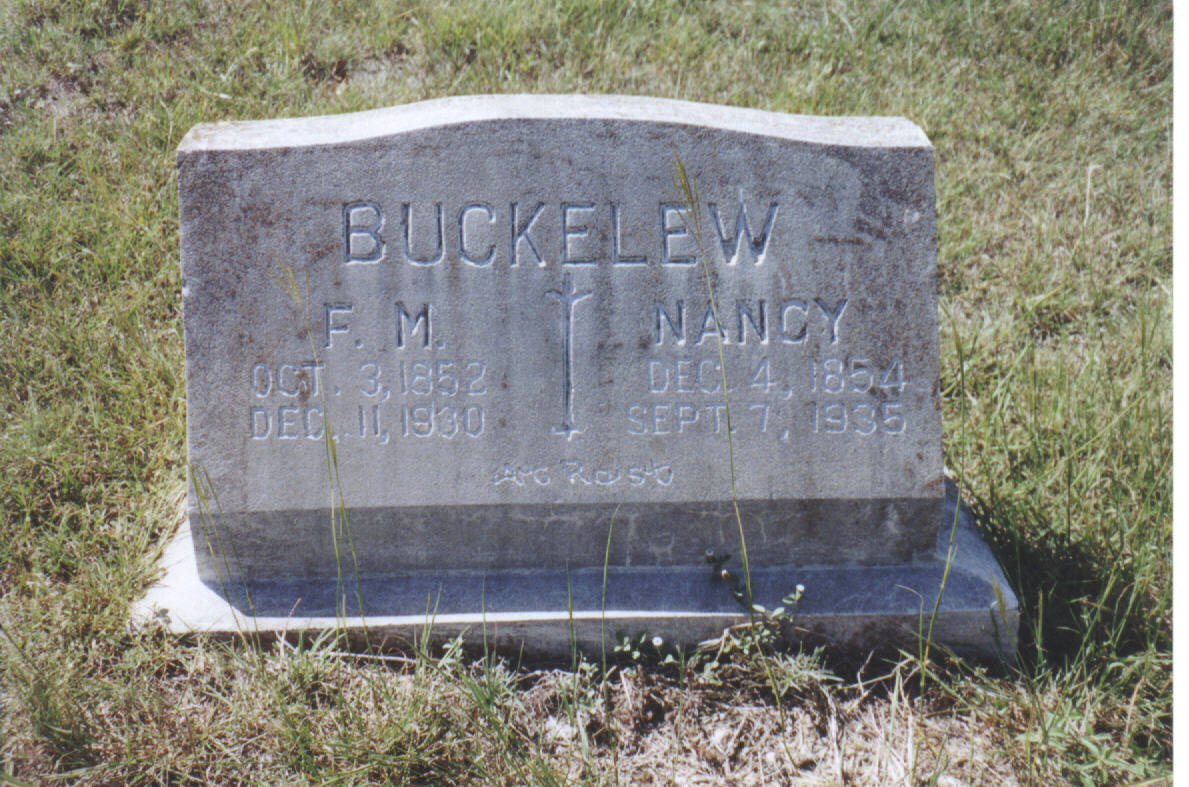
Another well-known settler was Frank Buckelew. He was a fourteen year-old orphan living with his two sisters on Judge Davenport’s ranch. One day Frank and a Negro boy were sent out to the range to find a missing cow bell. The boys noticed something in a thicket and upon investigation found an Indian hiding under a blanket. The Indian jumped up and chased after them. He hit Frank over the head with his bow and caught him. The negro boy was able to escape. The Indian took Frank up the mountain to the rest of his tribe. After the meeting, Frank was questioned by the Chief in broken English. They made Frank go the side of the mountain where he was visible at the ranch and call to his sisters. Luckily, the other boy had already made it back and warned them. The girls were suspicious and wouldn’t go out, even though they were worried about their brother. Eventually, the Indians left with Frank and returned to a large Indian encampment on the Pecos River. Frank remained with the Indians at this camp for many months. He learned how to make bows and arrows and how to use them while he was there. The Indians often took him with them when making trips to Mexico. On one of these trips, a young Mexican boy saw him and alerted an American named Hudson. The Mexican boy helped Frank escape from the Indians and go to Mr. Hudson’s home. Mr. Hudson brought Frank to Fort Clark and then returned him to his family. Frank never forgot his adventure and eventually a book based on his recollections was written by Mr. and Mrs. T.S. Dennis.
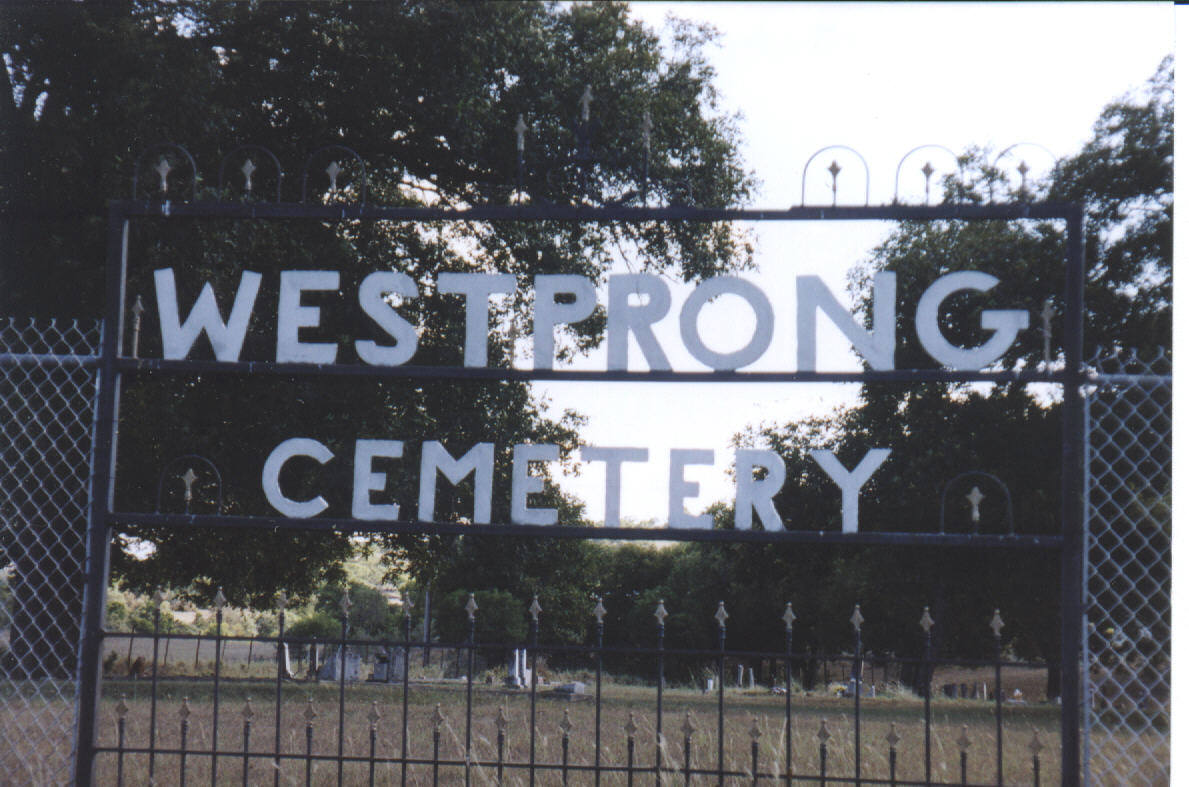
HISTORICAL LANDMARKS
Medina only has a few historical landmarks left. Most of its landmarks have been destroyed by floods or fire. Some of the buildings were torn down or severely remodeled. However, there are still a few places to visit. We visited the Stanard House, the Old Hatfield Store, and the United Methodist Church. There are two other churches in Medina, the Church of Christ and the First Baptist Church. They were established in the 1880’s, but their buildings are newer. There are also three cemeteries around Medina: Oak Rest, West Prong, and Goodman. None of the original school buildings still exist in Medina. Despite the destruction of many of its earliest buildings, it’s still an interesting little town to checkout on a weekend afternoon.
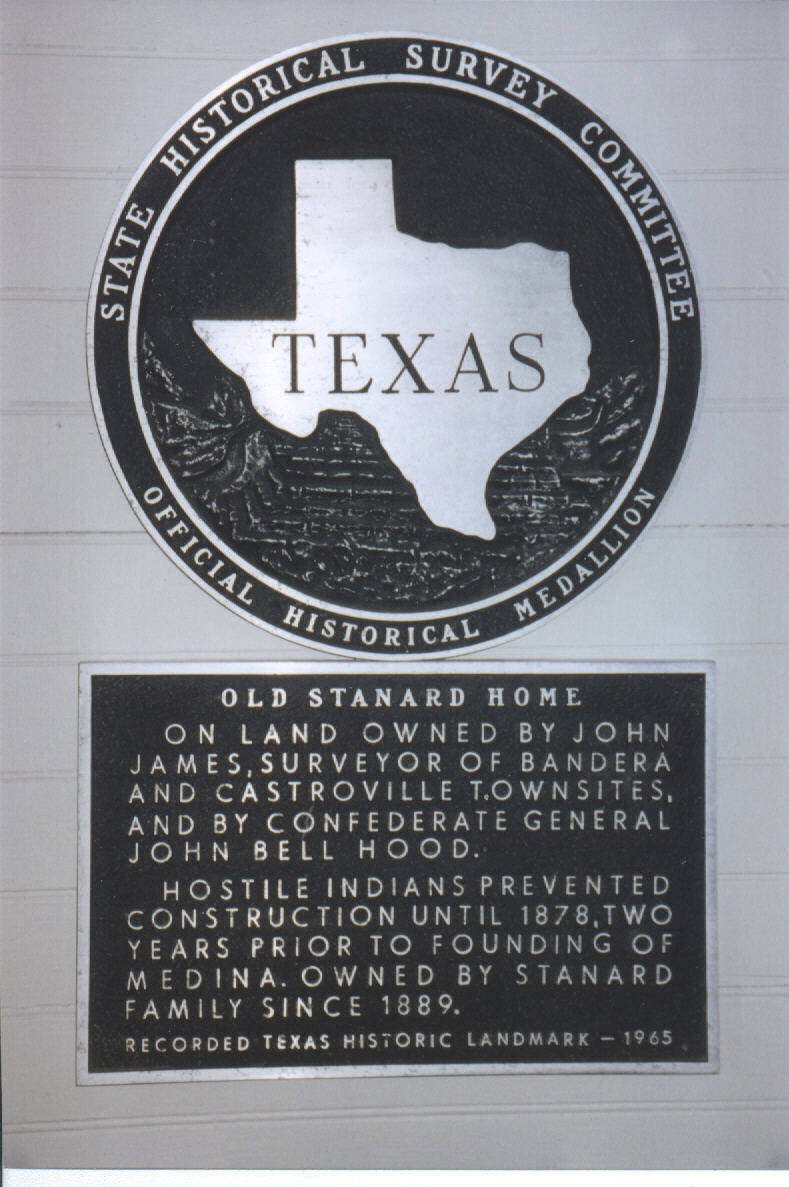 The Stanard House is on the left as you approach Medina from Bandera. It is a beautiful old home overlooking the Medina River. The house became a recorded Texas Historic Landmark in 1965. In 1876, H.H. Carmichael was a recent graduate of Columbia University and newly married. The new couple were hoping for a happy beginning in Medina. Shortly after Mr.Carmichael and his wife began building their home, they received news of Indians killing Jack Phillips in nearby Seco Canyon.
The Stanard House is on the left as you approach Medina from Bandera. It is a beautiful old home overlooking the Medina River. The house became a recorded Texas Historic Landmark in 1965. In 1876, H.H. Carmichael was a recent graduate of Columbia University and newly married. The new couple were hoping for a happy beginning in Medina. Shortly after Mr.Carmichael and his wife began building their home, they received news of Indians killing Jack Phillips in nearby Seco Canyon.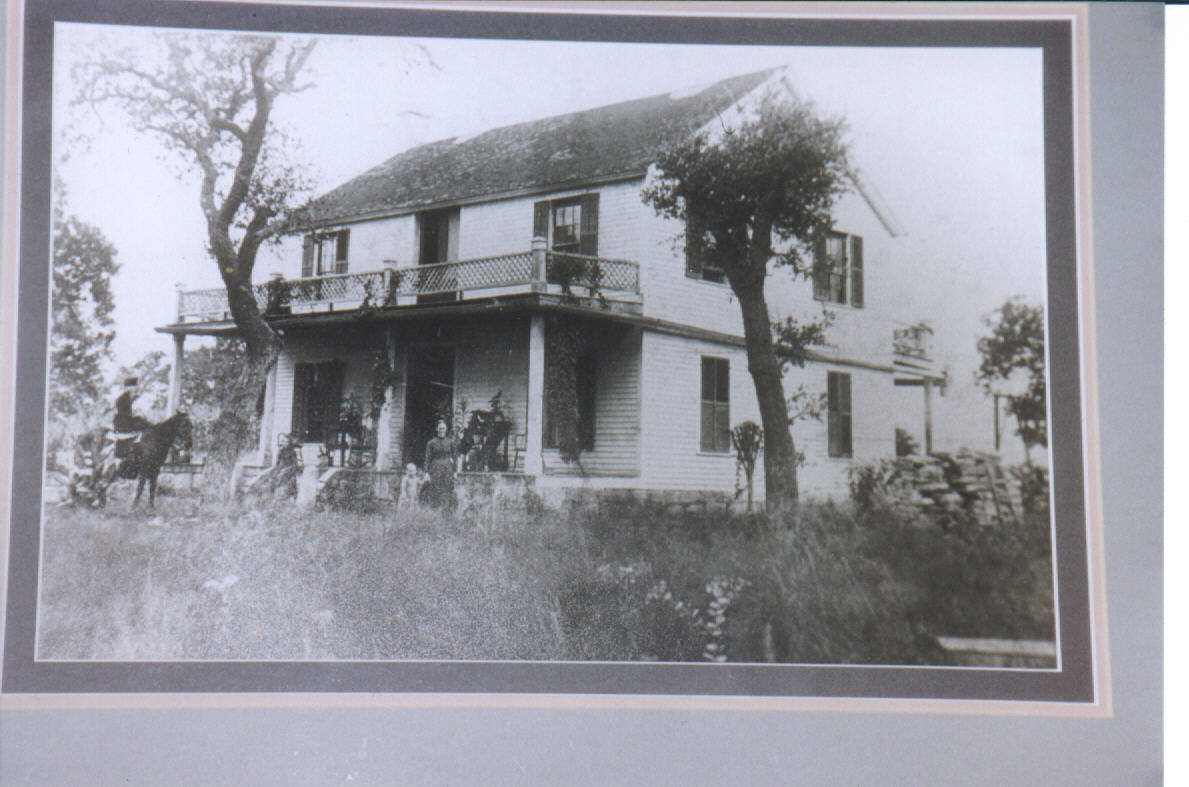 Mr. Carmichael had his house torn down and moved to Bandera. He sold the property to Charles T. Parker on October 28, 1878. A new house was built on the original site that same year. Mr. Parker sold the property to B.F. Bellows in 1879. In 1889, Harvey Stanard bought a tract of property from Mr. Bellows, the house was part of this tract. Ada Mae Stanard Nesting still owned the home until her death in 1973. The current owner's are Inman and Sandra Dabney. The Stanard House has been kept in excellent condition. There has been some updating and improvements to the home, such as the balcony over the porch being removed. However, it still has the original hard wood floors which are in great shape. The house is filled with antiques and old pictures of the house from many years before. It is definitely a sight to see if you are ever in the area.
Mr. Carmichael had his house torn down and moved to Bandera. He sold the property to Charles T. Parker on October 28, 1878. A new house was built on the original site that same year. Mr. Parker sold the property to B.F. Bellows in 1879. In 1889, Harvey Stanard bought a tract of property from Mr. Bellows, the house was part of this tract. Ada Mae Stanard Nesting still owned the home until her death in 1973. The current owner's are Inman and Sandra Dabney. The Stanard House has been kept in excellent condition. There has been some updating and improvements to the home, such as the balcony over the porch being removed. However, it still has the original hard wood floors which are in great shape. The house is filled with antiques and old pictures of the house from many years before. It is definitely a sight to see if you are ever in the area.
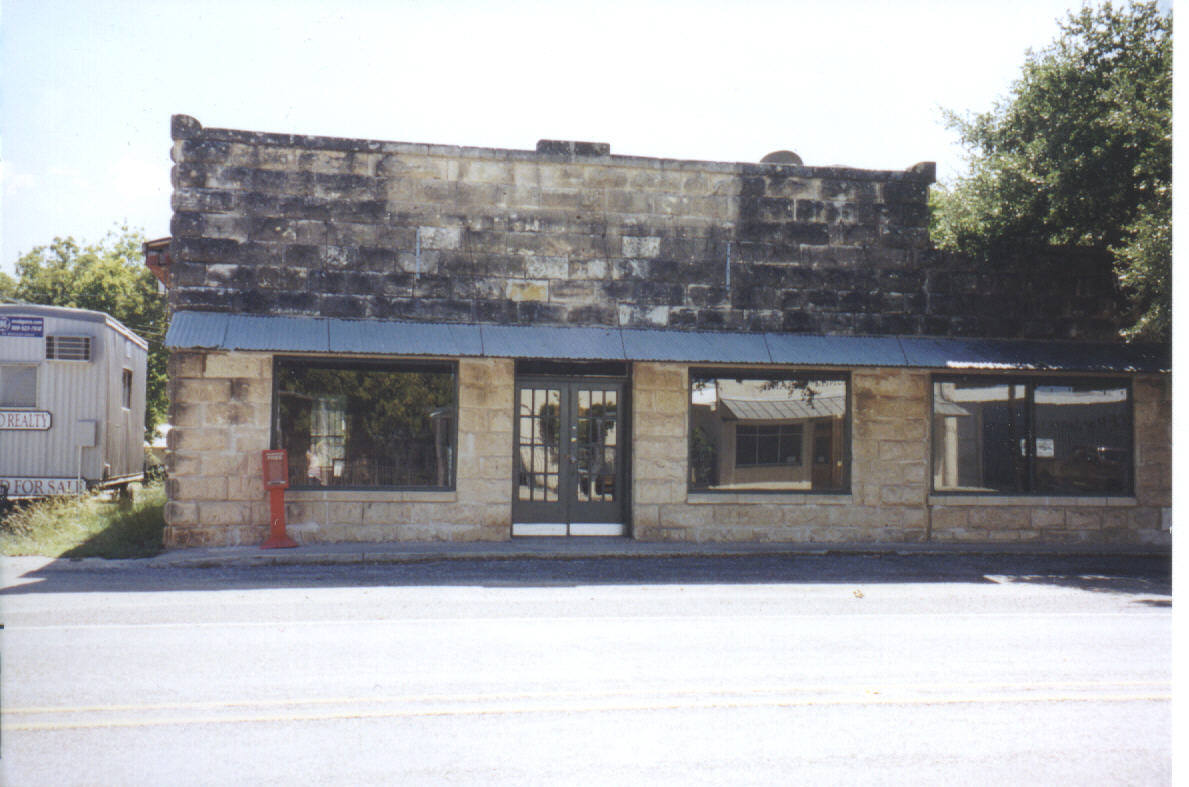
One of the most important landmarks in Medina is the Old Hatfield Store. It is located on Main Street in Medina. The Old Hatfield Store was built in 1888. It has been in the Hatfield Family since 1909, almost a hundred years. The store is made out of native limestone that has lasted all these years. The Hatfield Store was a popular place where area residents traded goods; such as wool, mohair, horse saddles, shoes, clothes, material and much more. Prior to 1937, there was not any electricity. Candle sticks, coal lamps, and lanterns were the only sources of light. Heat came from a wood burning stove which the residents would crowd around to keep warm. The store has been owned by many different people through the years, some of these include: A.M. McNeil, H.H. Carmichael's son, Bud Hodges, Gave Lewis, and the present owner, W.O. Hatfield. Dot Ferguson Hatfield, one of the women we interviewed, is the wife of Mr. Hatfield. Today, the Hatfield store is empty, but under construction. The Hatfield Family wants to renovate the building into offices, but leave the shell of the old store.
The West Prong Methodist Church was established in 1881. It later became the Medina Methodist Church. The first minister was George Killough. There were 18 charter members.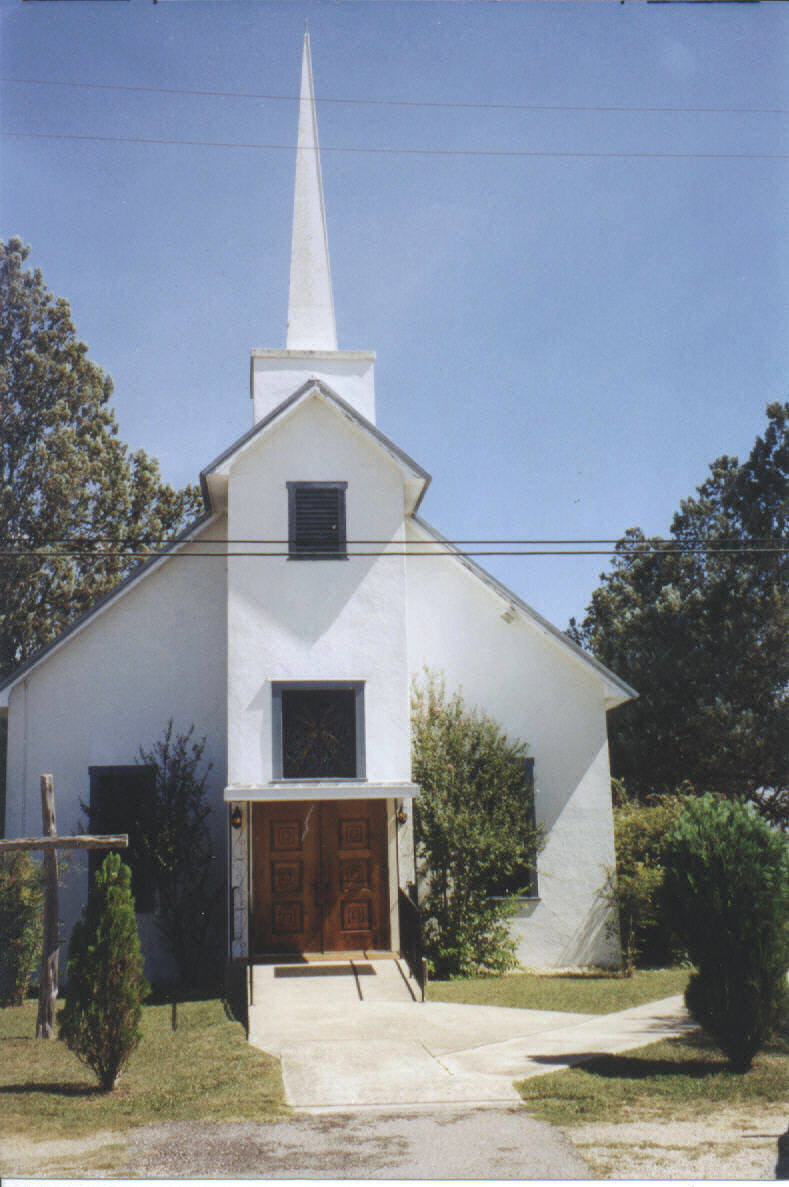 Their names were: Mr. and Mrs. J.P. Akin, Mr. and Mrs. J.S. Akin, Mr. and Mrs. J.L. Renshaw, Mr. and Mrs. S.J. Thorn, Mr. and Mrs. George Smith, Mr. and Mrs. O.W. McBryde, Mr. and Mrs. W.B. Baker, Mr. and Mrs. J.T. Stevens, and Mr. and Mrs. J.A. Tegart. On September 1, 1881, the people living along the West Prong of the Medina river petitioned the county commissioners for a free public school. The petition was granted and O.W. McBryde donated land for the school. A building was erected near the West Prong Cemetery at the mouth of the Coal Kiln Creek. Mrs. Chisum became the school’s first teacher. Church and Sunday school were also held there for the next eight years. On October 19, 1888 at the quarterly conference of the church, permission was granted to build a church in Medina City. Harvey Stanard donated land to build the church on. The present church was built the summer of 1889 on this lot by the river. Church and Sunday school services were moved to the new church in August of 1889. Mr. B.F. Bellows thought it was important that the church have a bell, so he convinced his friend Mr. M.L. Allen of Massachusetts to donate one. The bell was cast in Troy, New York by the Meneely Bell Foundry in 1889. Mr. M.L. Allen had these words engraved on the bell: Presented to Methodist Church South Medina, Texas by M.L. Allen of Massachusetts “Let him that heareth say, Come” Revelations 22:17. Over the years, the church grew quite a bit, with this growth came the need for expansion and remodeling projects. A room was added to each side of the rostrum on the church and the building was stuccoed in 1938. In 1946, a youth center was built. This building has been used for youth activities, church functions, Sunday school, and community affairs. Finally, in 1974, a steeple was added which seemed to complete the church.
Their names were: Mr. and Mrs. J.P. Akin, Mr. and Mrs. J.S. Akin, Mr. and Mrs. J.L. Renshaw, Mr. and Mrs. S.J. Thorn, Mr. and Mrs. George Smith, Mr. and Mrs. O.W. McBryde, Mr. and Mrs. W.B. Baker, Mr. and Mrs. J.T. Stevens, and Mr. and Mrs. J.A. Tegart. On September 1, 1881, the people living along the West Prong of the Medina river petitioned the county commissioners for a free public school. The petition was granted and O.W. McBryde donated land for the school. A building was erected near the West Prong Cemetery at the mouth of the Coal Kiln Creek. Mrs. Chisum became the school’s first teacher. Church and Sunday school were also held there for the next eight years. On October 19, 1888 at the quarterly conference of the church, permission was granted to build a church in Medina City. Harvey Stanard donated land to build the church on. The present church was built the summer of 1889 on this lot by the river. Church and Sunday school services were moved to the new church in August of 1889. Mr. B.F. Bellows thought it was important that the church have a bell, so he convinced his friend Mr. M.L. Allen of Massachusetts to donate one. The bell was cast in Troy, New York by the Meneely Bell Foundry in 1889. Mr. M.L. Allen had these words engraved on the bell: Presented to Methodist Church South Medina, Texas by M.L. Allen of Massachusetts “Let him that heareth say, Come” Revelations 22:17. Over the years, the church grew quite a bit, with this growth came the need for expansion and remodeling projects. A room was added to each side of the rostrum on the church and the building was stuccoed in 1938. In 1946, a youth center was built. This building has been used for youth activities, church functions, Sunday school, and community affairs. Finally, in 1974, a steeple was added which seemed to complete the church.

UNUSUAL EVENTS
Love Creek Orchards is one of Medina’s biggest attractions. Medina was named by the Department of Agriculture as The Apple Capital of Texas in 1988. Baxter Adams first planted an experimental orchard of 1,000 dwarf apple trees in 1981. In 1984, these trees became mature enough to produce a good size crop. There are three pluses to growing apples in Medina: 1) they produce apples earlier than any other region, 2) they have a longer growing season, and 3) the trees have the longest recovery period after crop production. The dwarf trees are also extremely efficient in land usage. Love Creek Orchards produces about eleven varieties of apples. These different types of apples include: Mollie’s Delicious, Granny Smith, Gala, Crispin ( Mutsu), Jonagold, Red Chief, Lura Red, Anna, Dorsett Gold, Fuji, and Pink Lady. The apples in Medina were such a big hit that Love Creek Orchards has opened a store dedicated to Apple products. They sell all kinds of apple goods and even apple ice cream. In 1986, Baxter and Carole Adams invited some friends over for a barbecue in their orchards. By 1987, this had grown into the Medina Apple Festival. The festival started as a one day event. It grew into an eight day festival in 2005. Originally, it was ran by volunteers, but this year paid workers were needed. This festival includes live music, dances, performances, a petting zoo, jumping castles, and the famous apple pie eating contest. The Apple Festival draws about four to six thousand visitors each year. Unfortunately, this year was the last year for the festival. Now, we have to just wait and see what Medina has in store for us next.
CONNECTIONS TO COURSE THEMES
We were able to find some connections to course themes during this project. One of these connections was immigration. The people who immigrated here were from the South and other parts of Texas. They were displaced after the Civil War. Race goes along with this theme because as the white settlers were moving in, the Indians were being pushed out. It took a long time to settle Medina because the area was highly valued by the Indians. Medina was settled by whites. There are very few other races in the town, even today. Technology also played an important role. Medina was a thriving town until automobiles were introduced. As residents gained the ability to travel easily, businesses closed because they could travel to the larger towns nearby for supplies. Electricity was a major technological advance because it made life so much easier for the people to live. These were just a few of the connections that we found.
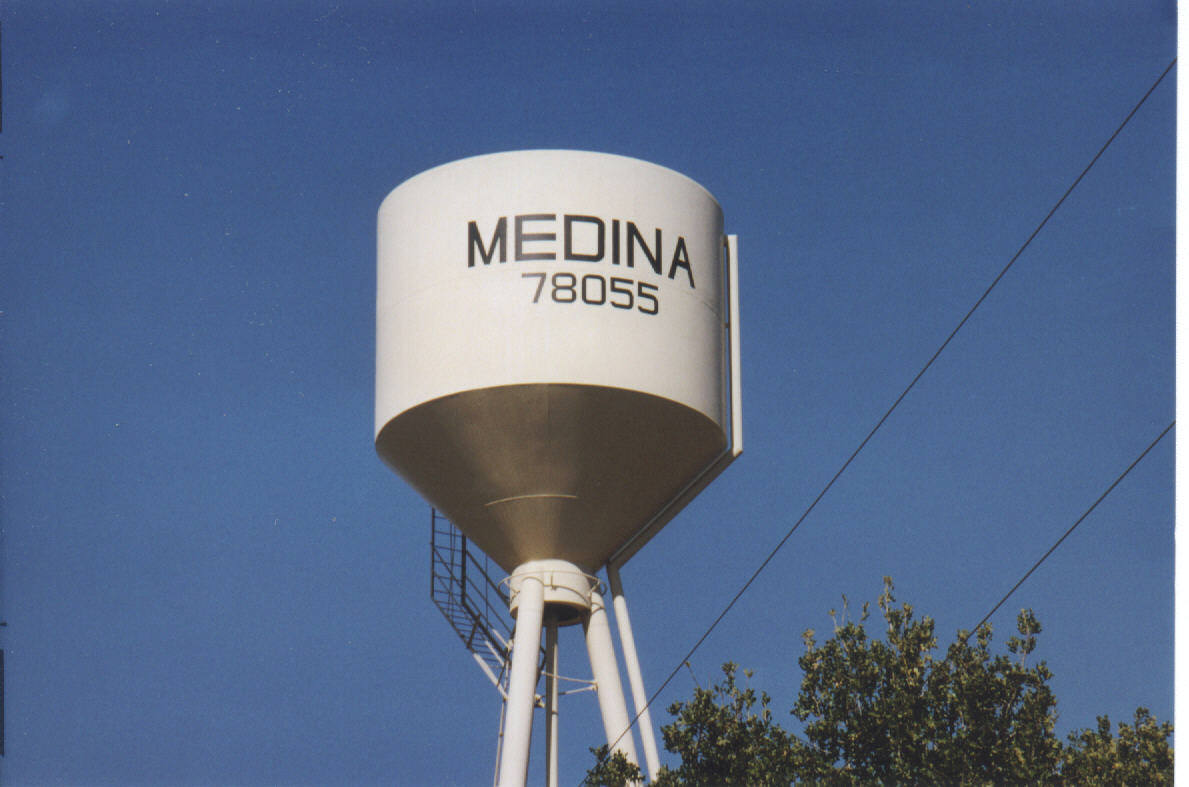
Medina is a small town that is in danger of dying out unless the residents can find a way to keep it alive. Expansion is a problem for Medina because of the Medina river and its branches. A lot of the land floods because of the river. The town’s origins come from a spirit of community. The early settlers of Medina faced many hardships when they settled there. However, they worked together and survived. Many of the descendants of these families are still in Medina. Hopefully, they can draw on their roots to come up with a plan to revive the town. The people that we met were very friendly and helpful. We really liked the town and its residents. Dot Hatfield shared the reasons that she loves Medina in our interview. She said, “ I like knowing that when I walk down the street, somebody’s going to say “HI”. This may seem so simple, but it can make a huge difference in your life. That’s what Medina has; a warm, friendly atmosphere!
WEBSITES
We would like to thank Professor Hines for giving us this challenging project. We learned a lot.
Thanks to Rich Cochran. This project would not have been finished without all of your help.
Thelma Gallant has our utmost gratitude. Thank you for taking the time to answer all of our questions.
Many thanks to Dot Hatfield. Your help was greatly appreciated. We enjoyed meeting you.
Thank you so much to the Medina Genealogical Society. Without all of your hard work in that room, we would not have had such good sources of information.
The people who work at the Medina Library were helpful and friendly. Thank you!
To the town residents who we spoke to, thanks for your time and friendliness. It was much appreciated.
ANNOTATED BIBLIOGRAPHY
Committee, Bandera County History Book. History of Bandera County, Texas. Dallas, TX: Curtis, 1986. This book was full of detailed background information about Medina.
Adams, Baxter. Telephone Interview. 31 October 2005. Baxter owns and operates the Love Creek Orchards. He was very interesting and gave me a lot of information about apples and running an orchard.
Dennis, T.S. and Mrs. T.S. Dennis. Life of F.M. Buckelew The Indian Captive. Bandera, TX: Hunter’s Printing, 1925. This is an account of Frank Buckelew’s life as told by himself and recorded by the Dennis’.
Gallant, Thelma L. A History of the United Methodist Church of Medina 1881-1981. Bandera TX: Bandera Publishing, 1981. This booklet contained a lot of useful data about Medina’s history during its beginning years.
Gallant, Thelma. Personal Interview.24 September 2005. The lma is one of Medina’s local historian’s. She has written historical books about Medina. Thelma’s interview was very informative because she’s done a lot of research on Medina.
Hatfield, Dot Ferguson. Medina’s Changing Times. Boerne, TX: Boerne Printing, 1995. This Booklet had interesting tidbits about the community of Medina.
Hatfield, Dot Ferguson. Medina’s Early Days. Boerne, TX: Boerne Printing, 1995. This booklet supplied extra background for our research.
Hatfield, Dot Ferguson. Medina’s Memories. Boerne TX: Boerne Printing, 1995. This booklet provided us with the experiences’ of the pioneer residents in Medina.
Hatfield, Dot Ferguson. Personal Interview. 24 September 2005. Dot is a local writer and influential business woman in Medina. She has also written books about Medina’s history. Dot told a lot of interesting stories about Medina’s residents that she found in her own research.
Hunter, J. Marvin. One Hundred Years of Bandera 1853-1953. Bandera TX: Hunter’s Printing, 1953. This book gave a nice summary of important events that have happened in Medina over the early years of the town.
Hunter, J. Marvin. Pioneer History of Bandera County. Bandera TX: Hunter’s Printing,1922. This book tells very detailed stories about Medina from the pioneer’s perspective.
Jones, Cherry. Telephone Interview. 26 October 2005. Cherry is a direct descendant of the Keese and Sheppard families. She gave me a lot of background on Medina's earliest families.
Medina Texas Development Corporation. Medina Texas, The Apple Capitol of the World. 29 August 2005. The University of Texas at Austin. Bandera County. The Texas Handbook Online.29 August 2005. The University of Texas at Austin. Medina, Texas. The Texas Handbook Online. 29 August 2005.